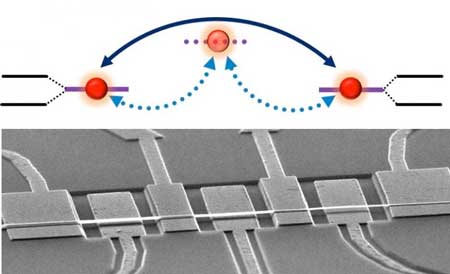| Posted: Jan 29, 2018 |
Scientists realize strong indirect coupling in distant graphene-based nanomechanical resonators
(Nanowerk News) New progress in graphene-based nanomechanical resonator systems has been achieved in Key Laboratory of Quantum Information and Synergetic Innovation Center of Quantum Information & Quantum Physics of University of Science and Technology of China (USTC). The jointed group, led by Prof. GUO Guoping, Research Associate Prof. DENG Guangwei from USTC and Prof. TIAN Lin from UC Merced, realized strong coupling between distant phonon modes, by introducing a third resonator as a phonon cavity mode. Varying the resonant frequency of the phonon cavity mode, the coupling strength between distant phonon modes can be continuous tuned.
|
|
The results were published in Nature Communications ("Strong indirect coupling between graphene-based mechanical resonators via a phonon cavity").
|
 |
| Schematic and scanning electron microscopy image of device architecture with a chain of three graphene-based nanomechanical resonators. (Image: USTC)
|
|
With the advantages of small size, stability and high quality factors, nanomechanical resonators are considered as a promising candidate to storage, manipulate and transfer information. Both classical and quantum information can be encoded on phonon states of mechanical resonators. Phonon states can also transfer such information. Because of the rapid development of quantum acoustics, it is attracting more and more research interests. Huge amount of theoretical and experimental work have been done on connecting different systems, storing and transferring information via phonon states ("Optoelectromechanical transducer: reversible conversion between microwave and optical photons").
|
|
The main problem of using nanomechanical resonator as information carrier is the realization of tunable phonon interaction at long distance. Many research groups around the world did a lot of studies on this problem. The most common way is to use optical cavities or superconducting microwave resonators as mediators. However, the difference between resonant frequencies of mechanical resonators and optical cavities or microwave resonators is too large. Also, the coupling strengths between them are relatively small, and hard to reach strong coupling regime.
|
|
Focusing on this problem, researchers proposed to employ mechanical resonator itself to act as a phonon cavity to replace the optical cavity or microwave resonator. The resonant frequencies of phonon cavity and mechanical resonators as information carriers are in the same range. Thus, these modes can be effectively coupled together. Previously, GUO's group realized strong coupling between neighboring mechanical resonators and coherent manipulation of phonon modes (Nano Letters, "Strongly coupled nanotube electromechanical resonators" and "Coherent phonon Rabi oscillations with a high frequency carbon nanotube phonon cavity").
|
|
Based on these work, scientists designed and fabricated a linear chain of three graphene-based nanomechanical resonators, as shown in Fig. 1. In this device, the resonant frequency of each resonator can be tuned in a wide range via local bottom metal gates. Such tunability provides the possibility to realize and modulate the coupling between resonators in different frequency ranges. Firstly, they observed the mode splitting of each neighboring resonators. It is found that in this structure, neighboring resonators are strongly coupled.
|
|
Such results provide foundations for the study on the coupling between the first and the third resonator. When the resonant frequency of the center resonator is tuned near to that of the side resonators, large mode splitting can be observed. Also they found that the splitting can be widely tuned via tuning the resonant frequency of center resonator.
|
|
This phenomenon is similar to Raman process in optics. The center resonator can be regarded as a mediating state, the phonon modes of side resonators can achieve effective coupling via exchanging virtual phonon with the mediating state (Fig. 1). Using the theoretical model of optical Raman process, they got the relation between effective coupling strength and detuning. The experiment data agrees well with the theoretical results.
|
|
It is the first time to experimentally realize non-neighboring coupling in graphene-based nanomechanical resonators, and shed light on the studies of nanomechanical resonators. With the development of the studies on phonon states cooling, this work provides the foundation for storage and transfer of quantum information via phonon modes.
|

